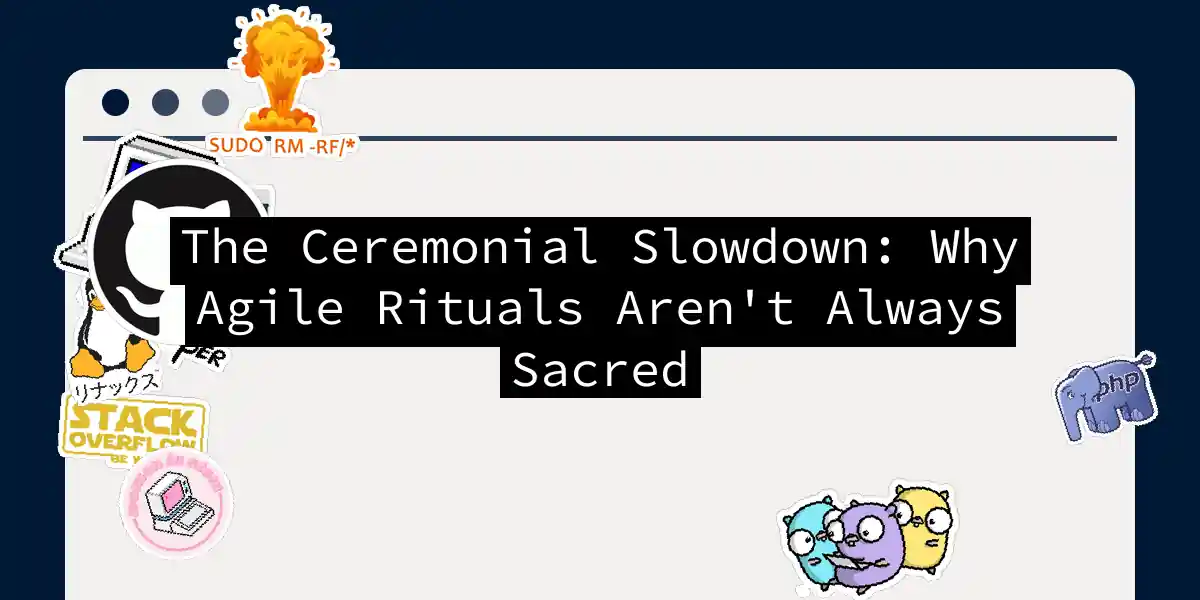Let me paint you a picture: It’s Monday morning. Your team gathers for sprint planning. Tuesday brings the daily stand-up where everyone recites their tasks like sleep-deprived zombies. Wednesday? Grooming session. Thursday? Review. Friday? Retrospective. Rinse and repeat until the heat death of the universe. If this sounds suspiciously like a liturgical calendar rather than a development process, you might be suffering from ceremony overload – the Agile equivalent of filling your codebase with comments that say “fix later.” The truth is, while Agile ceremonies can grease the wheels of collaboration, treating them as mandatory sacraments often derails velocity. Let’s dissect why rigid adherence to these rituals sometimes does more harm than good, and crucially – how to fix it.
The Hidden Costs of Ritual Adherence
Agile’s fluidity is its superpower, but that same flexibility becomes kryptonite when ceremonies fossilize into dogma. Consider these tangible drawbacks:
- The Planning Poker Paradox
Sprint planning should clarify priorities, yet I’ve seen teams burn 3 hours debating whether a task is a “5” or “8” while the actual work gathers dust. This false precision creates:- Illusory predictability ()
- Resource misallocation ()
- Analysis paralysis where action should reign
- Documentation Black Holes
When stand-ups replace specs, knowledge evaporates faster than my motivation before coffee. This isn’t theoretical:Agile’s “working software over documentation” mantra often mutates into “no documentation at all” – a disaster for onboarding or audits ().# Bad: Tribal knowledge trap def deploy(): # Ask Dave about the server config # (he’s on vacation next week) pass # Better: Lightweight but traceable def deploy(): # Server config: # See CONFIG.md#aws-setup (updated 2025-07-10) execute_automated_deploy() - The Retrospective Groundhog Day
How many retros have you attended where:- Action items from last retro weren’t completed?
- The same grievances resurface (looking at you, CI pipeline)?
- Solutions remain abstract (“communicate better”)? When rituals become rote, they embody Einstein’s definition of insanity.
A Practical Toolkit for Ceremony Reform
Step 1: The Ceremony Autopsy
Every quarter, run this diagnostic with your team:
Step 2: Right-Sizing Rituals
- Stand-ups: 15 minutes max. If someone mentions “synergy” or “low-hanging fruit,” fine them €5.
- Retros: Ban vague complaints. Require proposals formatted as:
Problem: [Observable behavior] Proposed Fix: [Testable action] Owner: [Name] Deadline: [Date] - Planning: Timebox estimation debates. If consensus isn’t reached in 3 minutes, flip a coin and move on. Seriously.
Step 3: Replace Ceremonies with Code
Automate what ceremonies clumsily attempt:
- Replace status updates with CI pipeline badges
  - Migrate task tracking from JIRA theater to Git hooks:
# Pre-commit hook that blocks vague commit messages if [[ "$COMMIT_MSG" =~ .*(fix|update|improve).* ]]; then echo "Commit message too vague! Be specific." >&2 exit 1 fi - Embed retrospectives into code reviews:
+ // REFACTOR: Cyclomatic complexity reduced from 12 → 4 + // LEARN: Extract method pattern applied here - // TODO: Handle edge case (card #PROJ-123)
When Ceremonies Earn Their Keep
Not all rituals are evil. Effective ceremonies:
- Exploit friction: A heated retro after a production incident > scheduled Friday lamentation
- Create artifacts: Design sprint results in Figma prototypes, not just stickies
- Solve concrete problems: Sprint planning that resolves dependency deadlocks The distinction? Purpose over habit. A stand-up that surfaces blockers is gold; one that recites JIRA tickets is performance art.
The Manifesto You Actually Need
Let’s rewrite sacred scripture:
Individuals and interactions over processes and tools
*...but document what the noisy person in the corner agreed to*
Working software over comprehensive documentation
*...unless you’re handing this to another team next quarter*
Customer collaboration over contract negotiation
*...provided they don’t think "MVP" means "all features by Tuesday"*
Responding to change over following a plan
*...but track scope creep like it’s radioactive*
Agile at its best is a mindset, not a liturgy. Lose the dogmatism, keep the responsiveness, and for the love of all that’s holy – cancel that 2-hour grooming meeting tomorrow. Your codebase will thank you.
